Mexican Muralism is one of the most important artistic movements that have emerged in Mexico. The movement started in the 1920s, consolidated in the following decades and lasted until the second half of the 20th century.
The collection of murals at the Museo del Palacio de Bellas Artes covers over thirty years of this history and includes the work of prominent artists: José Clemente Orozco, Diego Rivera, David Alfaro Siqueiros, Rufino Tamayo, Jorge González Camarena, Roberto Montenegro and Manuel Rodríguez Lozano.
Many of these murals were commissioned especially for the building, however between 1963 and 1977, other murals like Carnival of Mexican Life, Allegory of the Wind, The Pietà in the Desert and Russian Revolution, were recovered from other sites, restored and incorporated into the Museum.
More than a linear and unified movement, muralism was characterized by the aesthetic and ideological differences between its protagonists, as manifested in the works and artists that make up this collection.
Diego Rivera
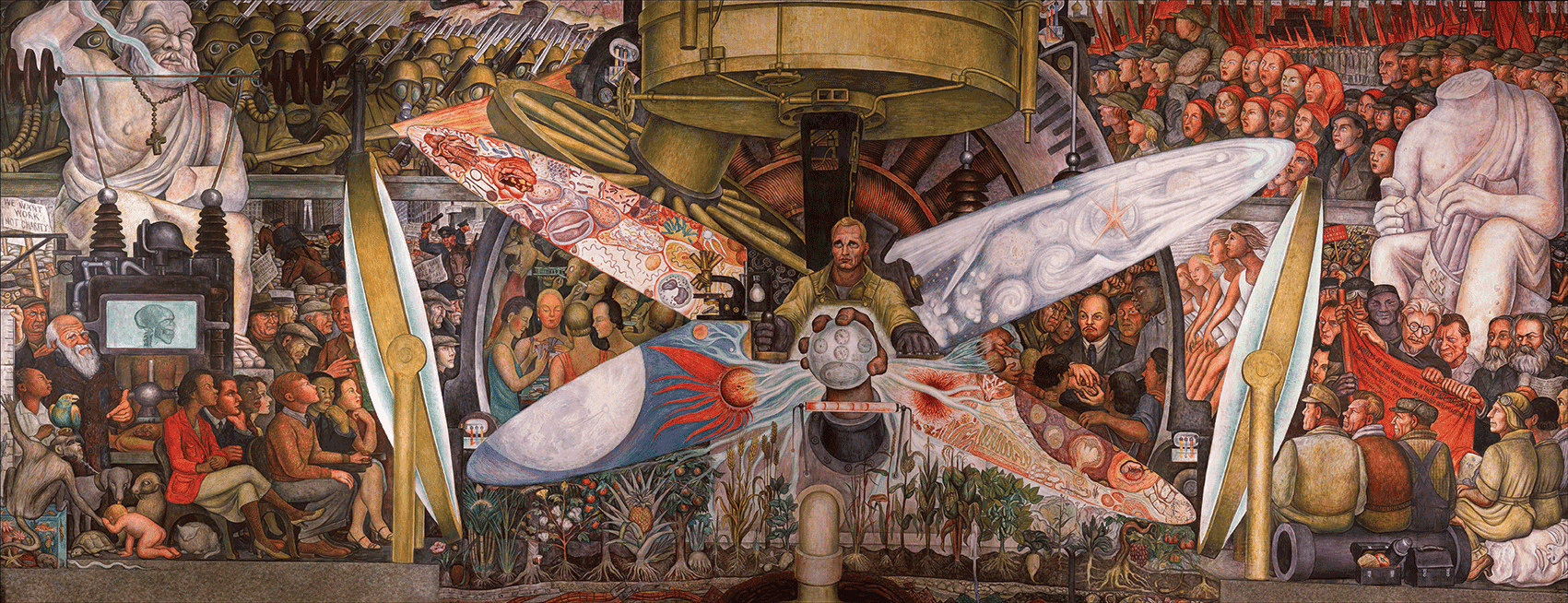
Diego Rivera
El hombre controlador del universo [Man, Controller of the Universe], 1934
Fresco on a portable framework
480 x 1145 cm
D.R. © 2023 Banco de México, Fiduciario en el Fideicomiso relativo a los Museos Diego Rivera y Frida Kahlo
[Comissioned for Palacio de Bellas Artes]
The inclusion of Lenin’s face was the trigger that led to the destruction of the first version of this mural painted in the lobby of Rockefeller Center in New York City. In 1934 Diego Rivera was invited to make a second version of the controversial work as part of the inaugural program of the Palacio de Bellas Artes.
In the center of the panel a blond worker is depicted looking uncertainly but hopefully towards the future while manually wielding a mechanical device that controls the micro and macro forces of the universe. This character is presented with an ethical and ideological decision: he must choose between the threat of capitalism represented by the United States and the promise of socialism represented by the Soviet Union.
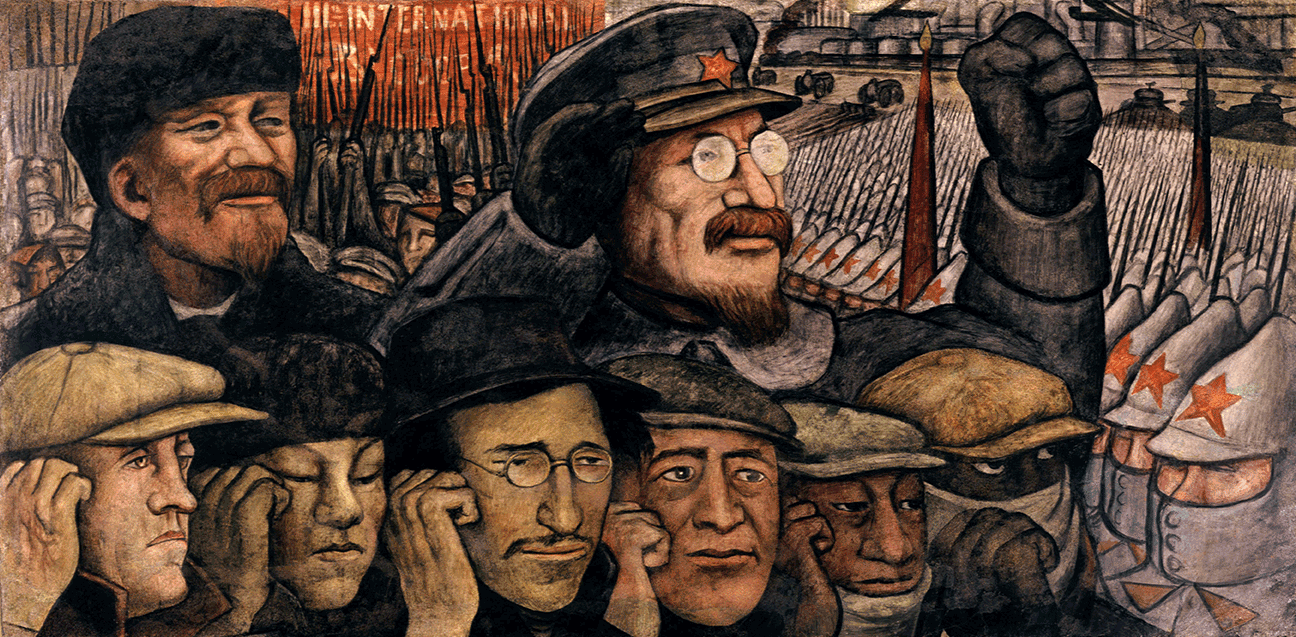
Diego Rivera
Revolución rusa [The Russian Revolution], 1933
Fresco on a portable framework
69 x 139 cm
D.R. © 2023 Banco de México, Fiduciario en el Fideicomiso relativo a los Museos Diego Rivera y Frida Kahlo
[Incorporated in 1977]
This small artwork was part of a series of mobile panels that Diego Rivera made with the money he received as compensation for the destroyed mural at Rockefeller Center. The mural cycle Portrait of America was originally commissioned for the New Worker’s School in New York and later divided into different collections. This panel, installed in 1977, depicts a group of workers of different nationalities listening carefully to the message of Vladimir Lenin and Leon Trotsky, who leads an army of peasants and workers. In the background, the banner of the Third International is depicted as a world call for proletarian revolution.
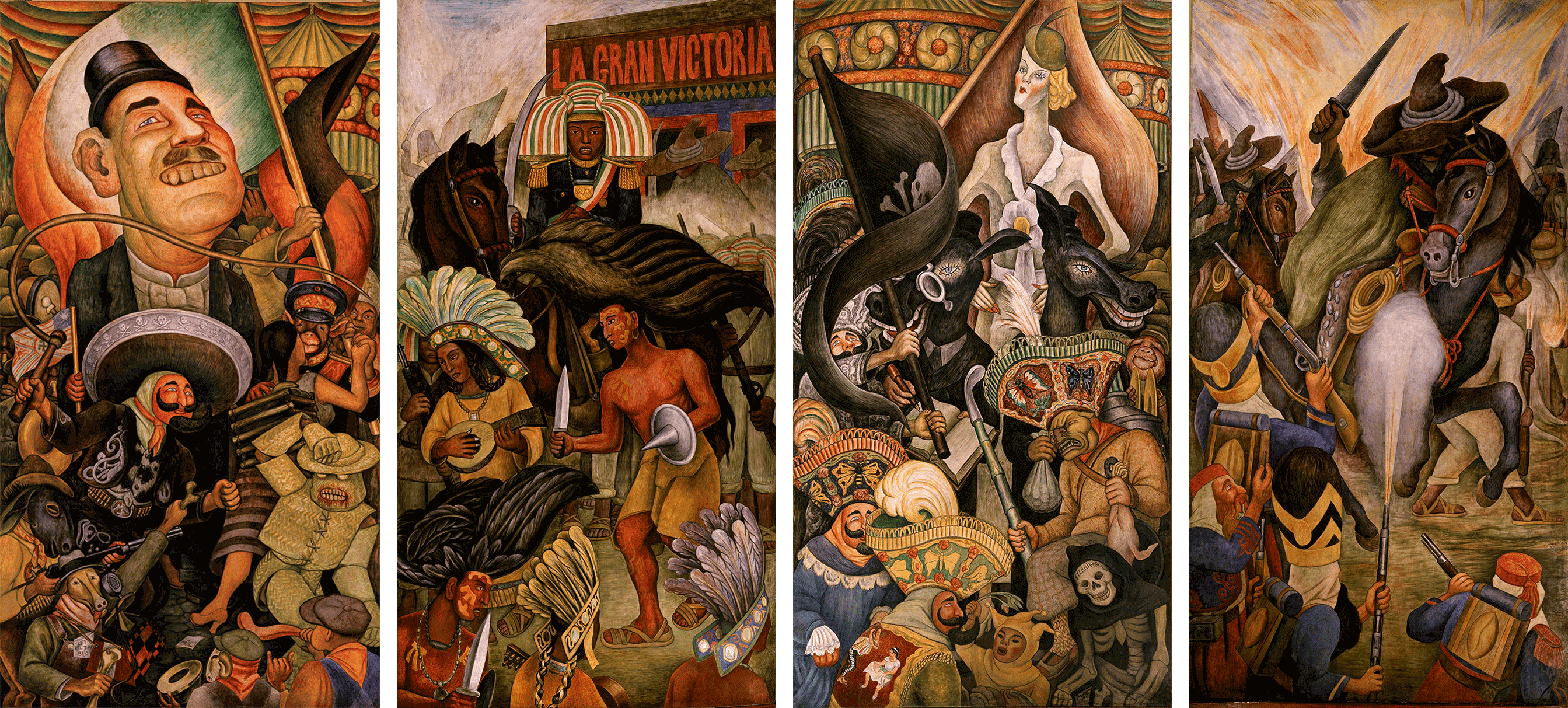
Diego Rivera
Carnaval de la vida mexicana [Carnival of Mexican Life], 1936
Frescoes on portable frameworks (four panels)
380 x 210 cm (each panel)
D.R. © 2023 Banco de México, Fiduciario en el Fideicomiso relativo a los Museos Diego Rivera y Frida Kahlo
[Incorporated in 1963]
This mural cycle was originally painted by Diego Rivera for the Hotel Reforma and was intended to attract foreign tourism. However, these murals were taken down due to their political content and stored for several years before their installation in the Palacio de Bellas Artes. Inspired by the Huejotzingo Carnival and the Yautepec Carnival, this cycle is composed by four panels: The Dictatorship, Dance of the Huichilobos, Folkloric and Touristic Mexico, and The Legend of Agustín Lorenzo. Rivera painted different allegorical figures to satirize the political and social landscape of that time, characterized by the relentless ambition for power and the corruption of the elites.
José Clemente Orozco

José Clemente Orozco
Katharsis, 1934–1935
Fresco on a portable framework
446 x 1146 cm
D.R. © José Clemente Orozco/SOMAAP/México/2023
[Comissioned for Palacio de Bellas Artes]
Painted at the same time as Rivera’s Man, Controller of the Universe, Orozco’s Katharsis is a blunt criticism of war, mechanization and mass politics during the modern era. The central scene shows a violent fight between two men and alludes to the class conflict between the bourgeoisie and the proletariat. This struggle opens in a spiral and merges with high-caliber weapons, monstrous machines, riddled bodies, and a protesting mob. The three prostitutes serve as a social commentary on the moral decadence and the hypocritical governmental policies enacted around prostitution. While apocalyptic, the intense flames at the top also symbolize the purifying fire that will give rise to a new society.
David Alfaro Siqueiros

David Alfaro Siqueiros
Nueva Democracia [New Democracy], 1944
Pyroxylin on celotex
550 x 1198 cm (central panel)
368.5 x 246 cm (lateral panels)
D.R. © David Alfaro Siqueiros/SOMAAP/México/2023
[Comissioned for Palacio de Bellas Artes]
This mural cycle was painted to commemorate the end of World War II and to celebrate the victory of the Allied forces over the Axis powers. The cycle is composed of three monumental panels—initially titled Victims of War, Mexico for Democracy and Independence and Victim of Fascism—and later received the name of New Democracy in 1945. This cycle celebrates the triumph of democracy over totalitarian systems, while showing the violence and the consequences of war over the civilian population through the representation of mutilated and tortured bodies. The dynamic and expressive forces of this murals were made possible thanks to the implementation of two technical innovations: on one hand the polyangular perspective for its composition, on the other, the use of pyroxylin, a cellulose-based industrial compound, often used in the automotive industry.
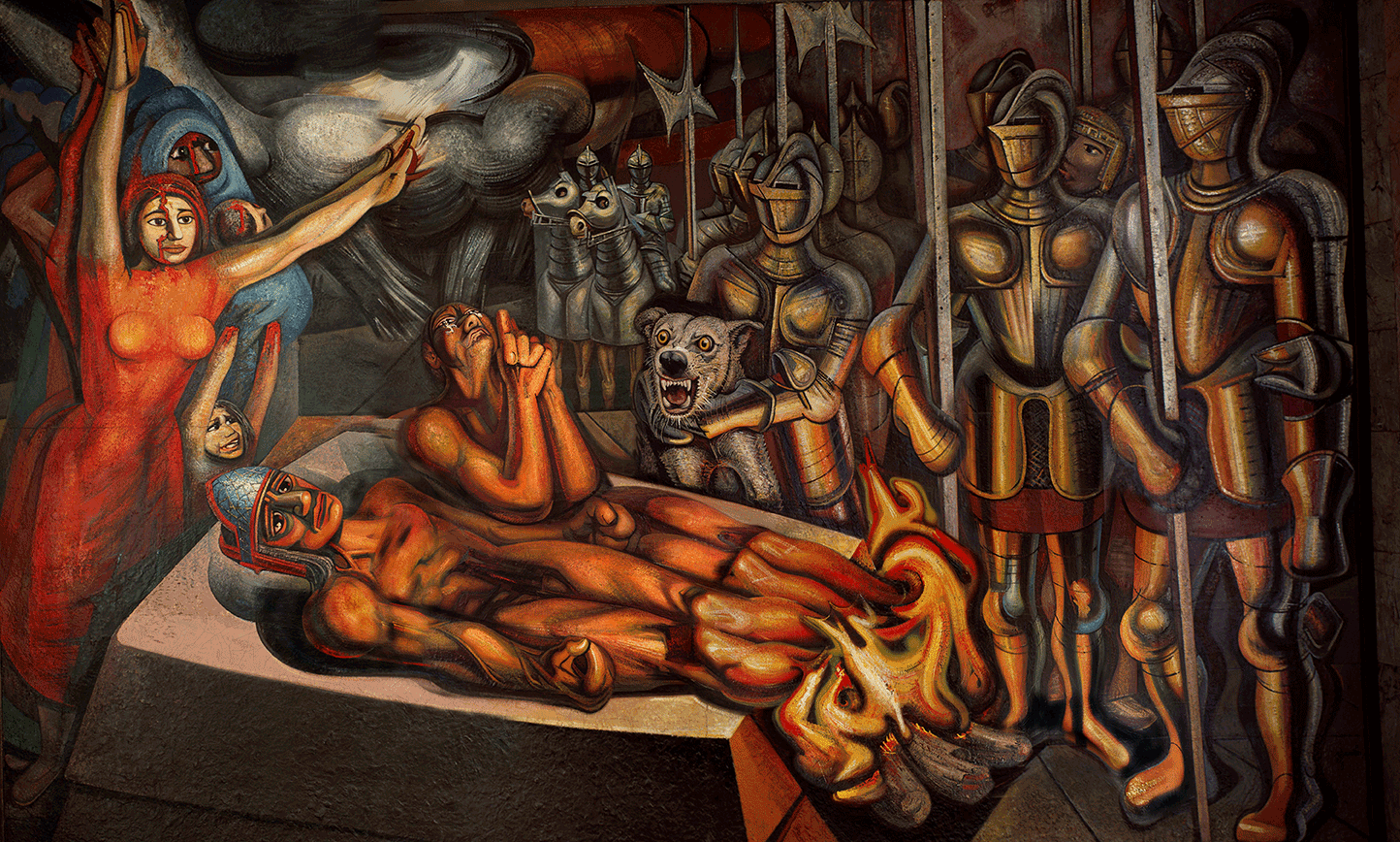
David Alfaro Siqueiros
Tormento de Cuauhtémoc [The Torment of Cuauhtémoc], 1950–1951
Pyroxylin on celotex
453 x 814 cm
D.R. © David Alfaro Siqueiros/SOMAAP/México/2023
[Comissioned for Palacio de Bellas Artes]
Inspired by the alleged finding of Cuauhtémoc’s remains by the anthropologist Eulalia Guzmán, Siqueiros created a two-panel mural cycle for the Palacio de Bellas Artes. This panel represents the moment when the Spanish conquerors burned the feet of Cuauhtémoc and Tetlepanquetzal, lords of Tenochtitlán and Tacuba. The brutality of this episode is reinforced by the group of women covered in blood that appears on the left as well as by the mad dog who shows his teeth as if ready to attack. Among a group of soldiers in armor, the face of Malintzin appears, considered then as a “traitor” and not as a fundamental figure in the process of the Spanish conquest.
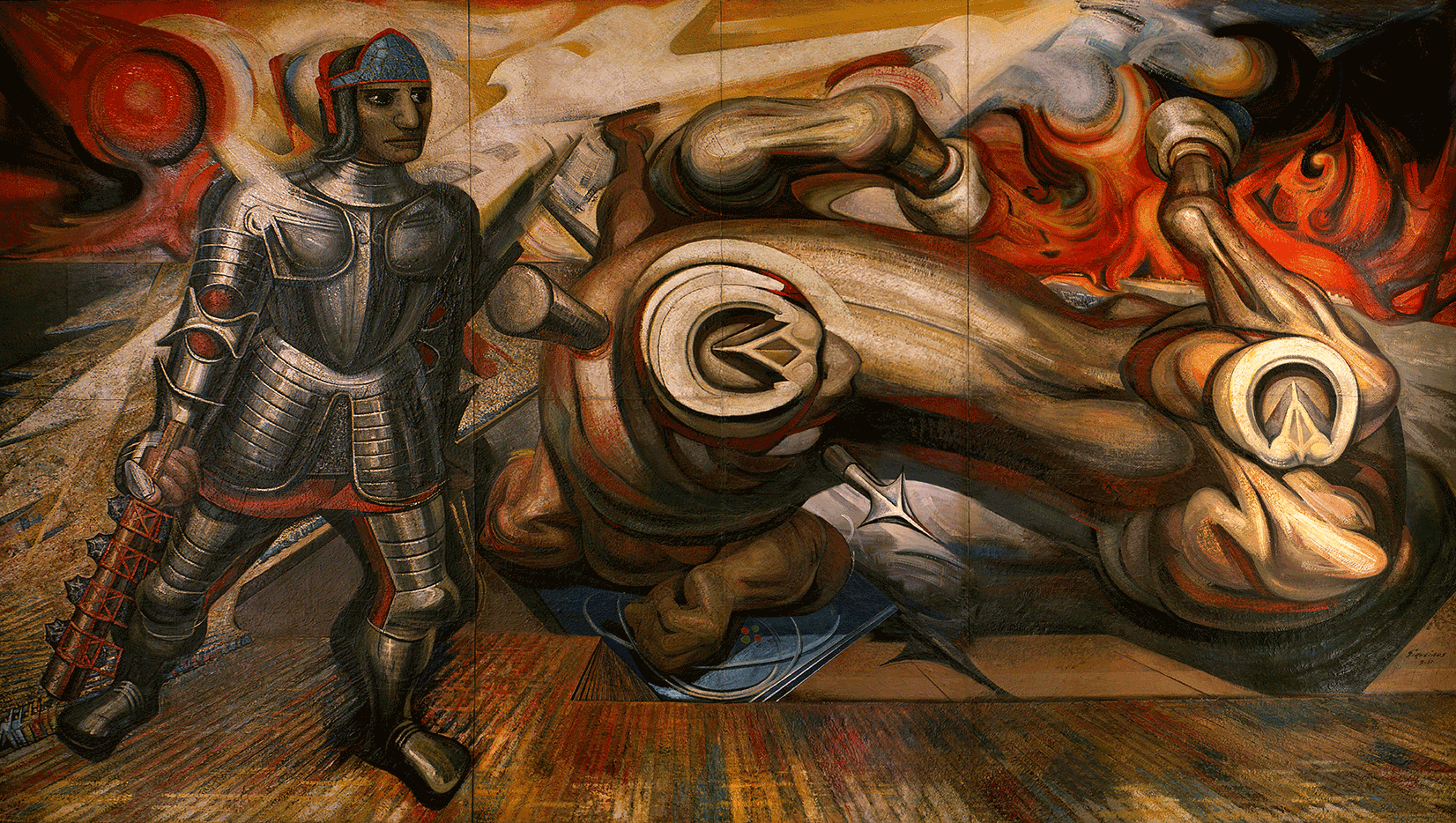
David Alfaro Siqueiros
Apoteosis de Cuauhtémoc [The Apotheosis of Cuauhtémoc], 1950–1951
Pyroxylin on celotex
449 x 795 cm
D.R. © David Alfaro Siqueiros/SOMAAP/México/2023
[Comissioned for Palacio de Bellas Artes]
An apotheosis is the culminating or triumphant moment of a situation, or the glorification or exaltation of a person. In this mural, Cuauhtémoc is dressed in shining armor and stands victorious with a club in his hand, having defeated the centaur of the Spanish conquest who lies on the ground, pierced by a spear. By turning the Mexica emperor into a symbol of resistance and dignity during the postwar years, Siqueiros wanted to signify that “Mexico and in general the weak people should firmly take up arms in their hands to defeat the enslaving enemies and executioners”.
Jorge González Camarena
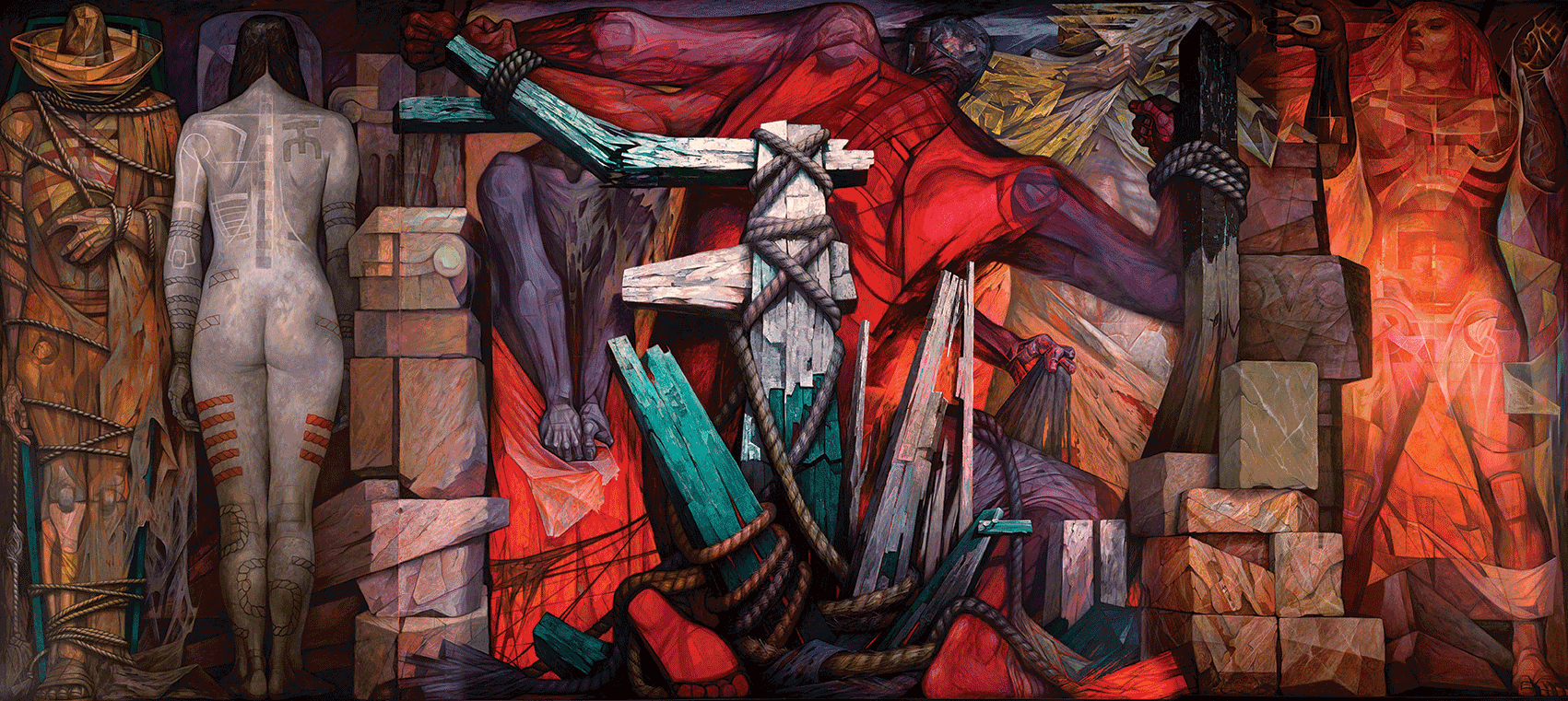
Jorge González Camarena
Liberación [Liberation], 1957–1963
Acrylic on canvas
449.5 x 993 cm
D.R. © Jorge González Camarena/SOMAAP/México/2023
[Comissioned for Palacio de Bellas Artes]
Liberation or Humanity frees itself from misery, by Jorge González Camarena, was the last mural commissioned to decorate the walls of the Palacio de Bellas Artes. This artwork was financed by a group of bankers in compensation for the destruction of two murals by the artist painted years before in the Guardiola Building. The central part of the mural shows a man from behind who fights against oppression and destroys the cross to which he is tied. This energetic figure is flanked on his left by a cadaverous-looking peasant, and on his right by a lively, resplendent woman. These two characters respectively symbolize the oppressive past and the promising free future of humankind.
Rufino Tamayo
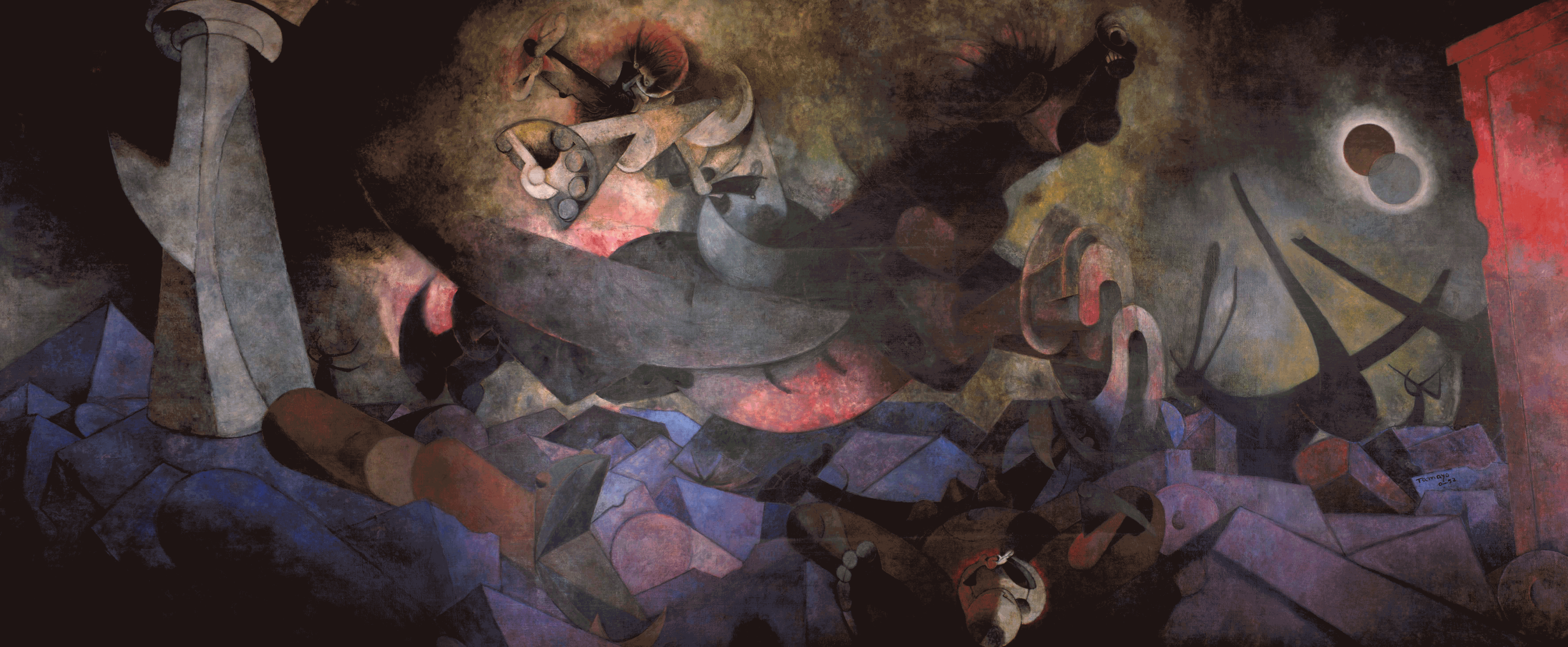
Rufino Tamayo
Nacimiento de nuestra nacionalidad [The Birth of our Nationality], 1952
Vinelite on canvas
510 x 1128 cm
© D.R. Rufino Tamayo/Herederos/México/2023/Fundación Olga y Rufino Tamayo, A.C.
[Comissioned for Palacio de Bellas Artes]
At the request of Carlos Chávez and Fernando Gamboa, Rufino Tamayo painted two murals in the Palacio de Bellas Artes. This mural can be interpreted as a pictorial response to Siqueiros’s aesthetic approaches. The Birth of our Nationality refers to the nationalistic discourse regarding the origins of a racial and cultural “mestizo” nation. The central figure shows a conqueror riding over the ruins of an ancient civilization. Amid a desolate landscape, a woman in labor represents the birth of the Mexican nationality as the violent conjunction between the Spanish and the indigenous cultures represented respectively by masculine and feminine attributes.
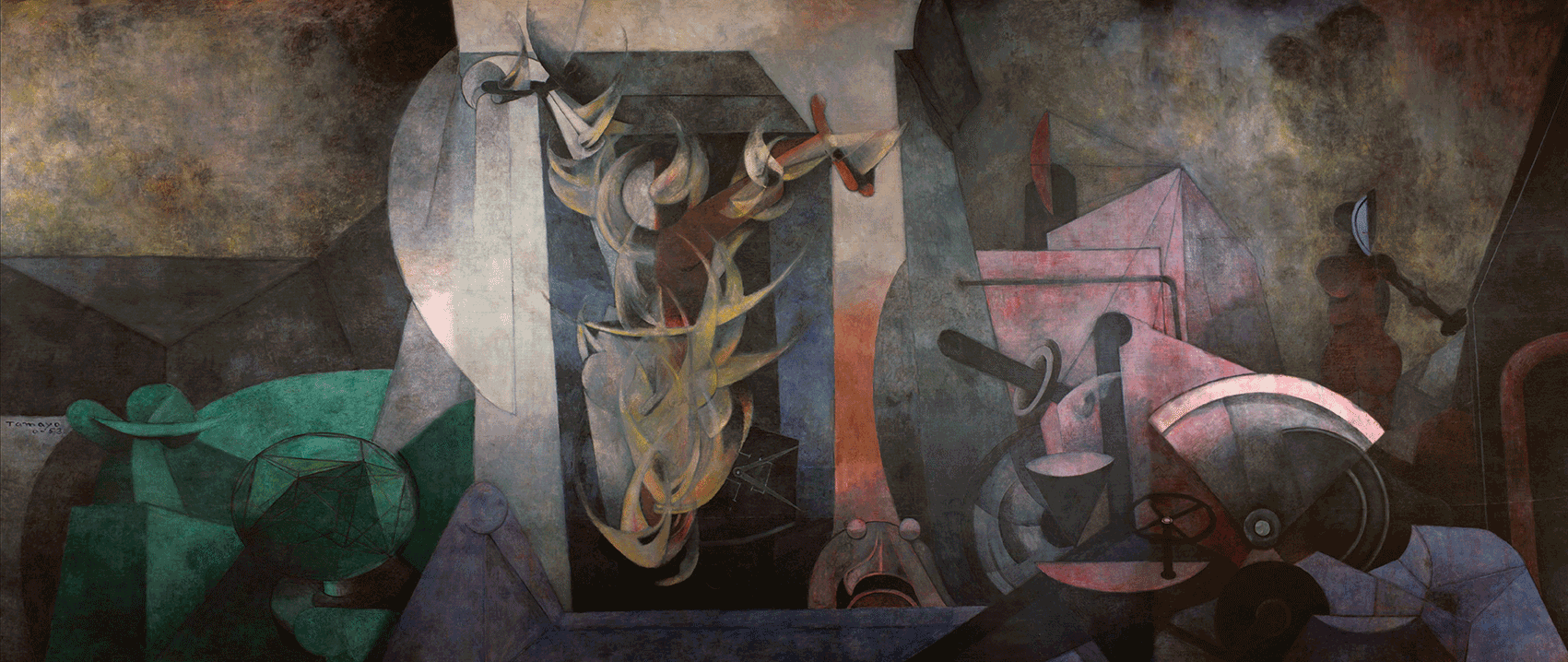
Rufino Tamayo
México de hoy [Mexico Today], 1953
Vinelite on canvas
510 x 1128 cm
© D.R. Rufino Tamayo/Herederos/México/2023/Fundación Olga y Rufino Tamayo, A.C.
[Comissioned for Palacio de Bellas Artes]
This mural replicates the discourse of mestizaje (racial mixing) as the structuring principle of the modern Mexican nation. In the center of the mural there is a construction painted in white that fuses European and Mesoamerican architectural elements. Inside, there is a figure that burns in flames and symbolizes the inextinguishable fire of the Mexican spirit of the present. To the left are the emerald ruins of the pre-Hispanic civilization, while to the right an industrial city emerges in shades of pink. The three sections of this mural evoke the colors of the Mexican flag.
Manuel Rodríguez Lozano
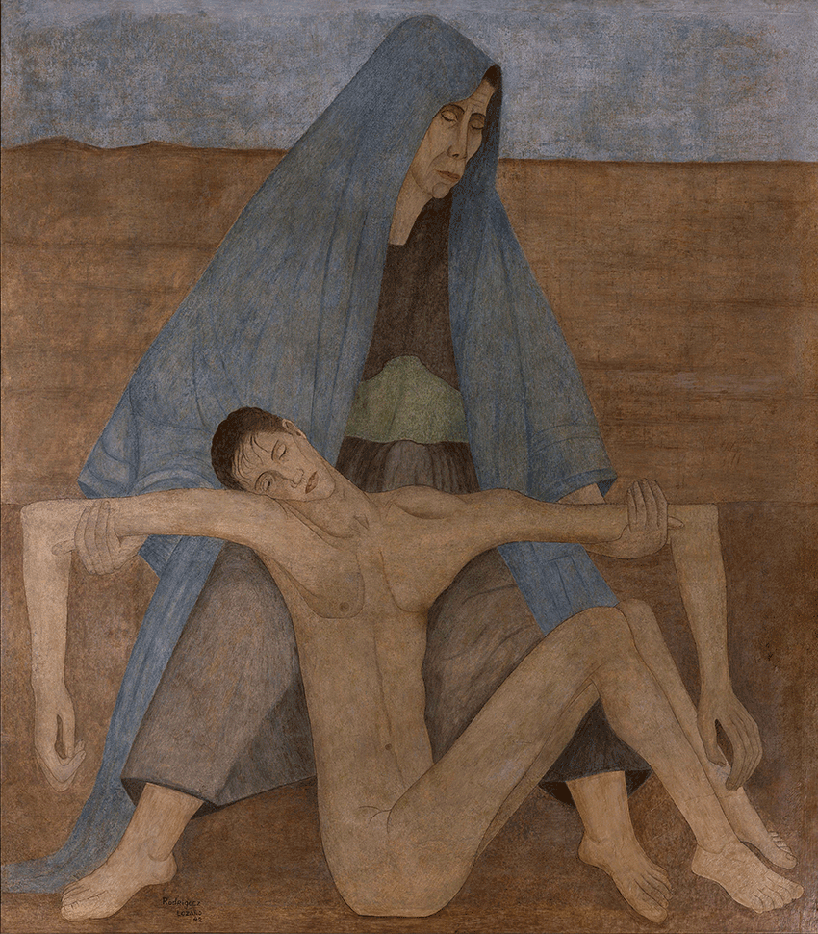
Manuel Rodríguez Lozano
La piedad en el desierto [Pietà in the Desert], 1942
Fresco on a portable framework
260.5 x 229 cm
[Incorporated in 1966]
The theme of Christian piety was reinterpreted by Manuel Rodríguez Lozano in this mural, painted in the Lecumberri prison while he was deprived of his freedom for four months, accused of a crime he never committed. The figure of the Virgin holding the dead body of her son is a tribute to the Mexican woman who, in the artist’s words, “has loving arms to lift her falling son, regardless of the crime or monstrosity he has committed.” The mural remained in Lecumberri until 1966, when it was removed, restored, and transferred to the Palacio de Bellas Artes.
Roberto Montenegro
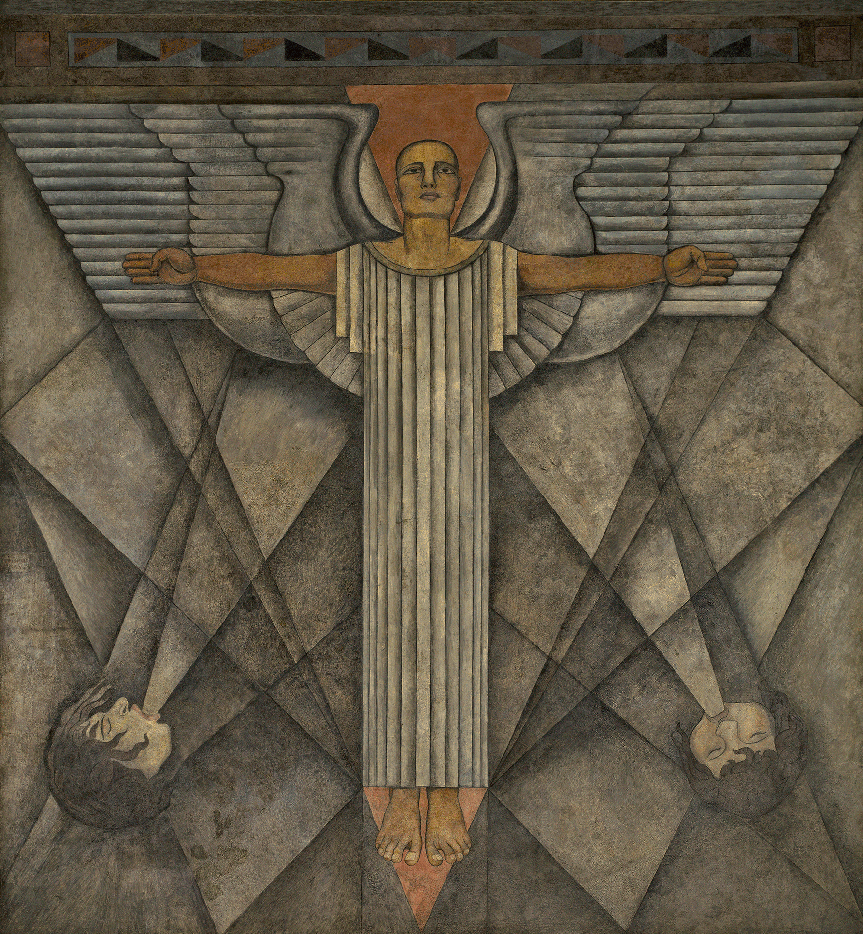 Roberto Montenegro
Roberto Montenegro
Alegoría del viento [Allegory of the Wind], 1928
Fresco on a portable framework
326 x 301 cm
D.R. © Roberto Montenegro/SOMAAP/México/2023
[Incorporated in 1965]
This fresco was part of a currently missing series of allegorical murals that Roberto Montenegro painted between 1922 and 1928 on the walls of the Colegio Máximo de San Pedro y San Pablo, where the first murals were painted. Allegory of the Wind represents an angel whose tunic resembles a marble column from which its shiny metallic wings unfold. With outstretched arms, he rises to the heavens thanks to the blowing of two Aiolos —wind divinities from Greek mythology— placed at the lower ends of the geometric composition. After being detached and restored, the mural was added to the Museum’s permanent collection in 1965.
